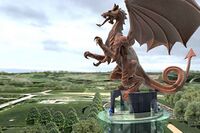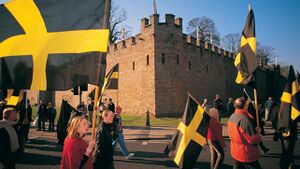Tinten: Difference between revisions
mNo edit summary |
mNo edit summary |
||
| Line 94: | Line 94: | ||
|footnote3 = | |footnote3 = | ||
}} | }} | ||
'''Tinten''', is a constitutional democracy in the [[International Democratic Union]]. Located on the south-east side of the continent of, and neighbored by Drambenburg to the west and the Olympic Ocean to the east. Officially founded in 1801 after a coup overthrew the Kingdom of Tintenburg. Known for being an agricultural and manufacturing power house with a loud and colorful culture. | |||
==Geography== | ==Geography== | ||
Tinten lies on the eastern coast of the continent of. Tinten is known for it's many rivers, especially Elbe River, which serves as the border between Tinten and Dramdenburg. Most of the nation is flat plains used for agriculture, with a hilly region in the north east | |||
Revision as of 20:08, 24 January 2020
The Republic of Tinten | |
|---|---|
|
Flag | |
| Motto: "Nun Tinten, Immer" | |
| Anthem: Wie Flüsse fließen | |
 | |
| Capital | Fulda |
| Official languages | German |
| Recognised national languages | German, English |
| Demonym(s) | Zelte |
| Government | Democracy |
• Präsidentin | Isaak Ritterbach |
| Population | |
• 2016 census | 47,000,000 |
| HDI (2016) | 0.78 high |
| Currency | Col (COL) |
| Date format | dd-mm-yyyy |
| Driving side | left |
| Calling code | +93 |
| Internet TLD | .tt |
Tinten, is a constitutional democracy in the International Democratic Union. Located on the south-east side of the continent of, and neighbored by Drambenburg to the west and the Olympic Ocean to the east. Officially founded in 1801 after a coup overthrew the Kingdom of Tintenburg. Known for being an agricultural and manufacturing power house with a loud and colorful culture.
Geography
Tinten lies on the eastern coast of the continent of. Tinten is known for it's many rivers, especially Elbe River, which serves as the border between Tinten and Dramdenburg. Most of the nation is flat plains used for agriculture, with a hilly region in the north east
Climate
Due to its location just north of the equator Cadair has a warm, tropical climate. The costal plains have an average temperature of 83F, and rarely dropping more than 20F at night, while the highlands average 67F due to the Snodoni Mountains blocking much of the southern ocean winds. Rainfall patterns are fairly constant, with an average 0f 173.8 rainy days each year, and raining anywhere between 1600 and 2100 millimeters every year.
Fauna
Cadair's long history as an island has not been friendly to animal, and the Republic of Prydania hunted much of the mammals and birds to extinction.
Demographics
The 2018 census of Cadair showed a population of 35,000,000, an increase of over 1,000,000 since the invitation of return for the Sileiro in 2015. This is set to increase with the legalization of immigration in 2020. The population density is 174 per square kilometer. Life expectancy is 82.34 and fertility rate is 2.4 per woman.
With the current ban on immigration, there is very little cultural differences in Cadair. Only the ethnic Cymry, Prydainians and the Sileiro inhabit the islands. There are a few illegal immigrants of various ethnicities that come through for tourism and attempt to stay in Cadair. An estimated 21 illegal immigrants are deported every year.
Religion
Due to the separation of Church and State dictated in Hawl I Rym, the Kingdom of Cadair has no official religion.
The largest religion in Wales is Cadwaladr, with 53.2 per cent of the population describing themselves as Cadwdr in the 2011 census. The
Addoliad Shrine, located outside Tenby sees over 1 million visitors every year.

Christianity was introduced in the eighth century with the arrival of the Prydanians, and was the official religion of the Prydainian Empire. Most Prydanians and some Cymry are Christian, totaling 31.7% of the population. Atheism and various ethnic cults also exist, but most foreign religions have no presence in Cadair.
The most significant cult is Hanghenfil, a group who worship a sleeping alien hidden under the seas. Followers of Hanghenfil believe that when Hanghenfil awakens, it will purify the world.
Culture
Cadair has developed a distinctive culture, nearly untouched by other civilizations. Since their independence from Prydania in 1983, the Cymry people tried to destroy any influence Prydanian culture had on them and return to their ancient traditions. Due to their shared history of enslavement and genocide, many aspects of Cymry and Gaeil culture have melded together.
Mythology
Entertainment Industry
Sports
The Cymry people hold a great love of sport, and many citizens are members of a sports club where they play for leisure and watch professional play.

The most popular sport is association futball (soccer), with 20 teams, divided into two leagues, the Cymry Premier League and the Cymry Second League, with the Cymru Futball Association participating in international friendlies and competitions.
The Cymry Boxing Association also has a large following in Cadair, with 13,000,000 annual attendees each year. The matches are split between two regions, the Eastern Division in Cardiff, and the Western Division in Aberystwyth, with the national finals alternating between the two capitols. Other sports have gained popularity in recent years, with many clubs adopting basketball and rugby, though either have yet to establish a professional presence in Cadair.
Music
Cadair has recently become known for its harpists, choirs, and solo artists. Cymry festivals are often accompanied with music and dancing, as well as the National Eisteddfod, a festival dedicated to Cymry music. Traditional music and dance in Cadair is supported by a myriad of societies. The Traditional Cymry Song Society has published a number of collections of songs and tunes.
The traditional instruments of Cadair are the Crwth and the harp, though, drums and the zither were adopted after the arrival of the Prydainian Tribes in 453 AD.
The Prydanian Empire founded the Imperial Orchestra in 1921 in an attempt to promote patriotism. Private orchestras and bands began to form in the mid 1950's as more people sought to be involved in music. Some of these orchestras and bands, such as TEAL, have become known internationally.
Festivals
Cadairians are known internationally for their love of festivals and holidays. There are three national festivals: Dydd Gwyl Dewi (St. David's Day), where participants wear daffodils, participate in parades and feast in the evening; Mari Lwyd (New Year's Day), filled with parades, dancing, drinking and fireworks; The biggest national festival is Day of Liberty , the anniversary of Cymry independence, marked with Cymry flags, the burning of the Prydainian flag and fireworks.

Cities
(See article: Cadair)
|
Largest Census Metropolitan areas in Cadair by population | |||||
| No. | CMA City |
Population | |||
| 1 | Aberystwyth | 12,092,000 | |||
| 2 | Cardiff | 11,237,000 | |||
| 3 | Port Talbot | 6,120,000 | |||
| 4 | Chepstow | 5,020,000 | |||
| 5 | Machynlleth | 5,005,000 | |||
| 6 | Bridgend | 1,943,000 | |||
| 7 | Tenby | 1,921,000 | |||
| 8 | Monmouth | 860,000 | |||
| 9 | Pontypridd | 753,000 | |||
| 10 | Fishguard | 694,000 | |||
| 11 | Carmarthen | 507,000 | |||
| 12 | Ruthin | 341,000 | |||
Government
Cadair is a Constitutional Monarchy, with the monarch, called Mab Darogan, wielding absolute power over the government. Most legal issues are localized under Mayors, who are elected by the people. The people are protected by the constitution, called Hawl I Rym. Hawl I Rym protects the rights of the people and gives them the right to impeach the mayors and to appeal to Mab Darogan in any legal matter.
National News
The Cadair Chronicle is the most popular Cymry news source, both domestically and internationally. It broadcasts through print, television, radio and the internet from its headquarters in Cardiff
The Cymry Free Press is also an extremely popular news source in Cadair, covering both hard and soft news. Many popular magazines, such as Sports Pictures and Popular Economics are owned by the Cymry Free Press.
Foreign Relations and Military
Even in it's short history Cadair has had a impact on international diplomacy. As a young, low population nation, war is a huge threat to Cadair, so Gerallt Morgan, 1st Mab Darogan, tried to make Cadair a safe place for communication between nations, by declaring Cadair a pacifist nation and a willing mediator for all international disputes. To further this, Gerallt Morgan had the Heddwch Tower built as a palace of international diplomacy. In a continuation of his pacifist plan, Gerallt Morgan formally disbanded the army and navy. He left the air force in place to prevent attacks on Cadair, but greatly lowered their numbers in funding.
In 2015, Mab Darogan passed the Cadair Security Act, which created the Cymry Peace Corps (CPC) to defend Cadair against hostile nations and to combat the growing drug trade. Realizing that having no formal military put his nation at risk of terrorist attacks or enemy espionage, Mab Darogan formed the Cyllellau a military force used to combat terrorist threats, collect espionage in other nations and neutralize potentially dangerous targets.
Treaties
Cadair was a key mediator in the Treviso Nuclear Treaty
Economy
Cadair is a free capitalist economy, putting few restrictions on companies. Cadair focuses on tourism, manufacturing, and mining. Cadair's exports account for 39% of its national output.
Tourism
Tourism is Cadair's leading industry as the islands rich history, beautiful climate and warm oceans bring millions of visitors every year. The opening seasons of the national sports leagues in 2018 caused a tremendous increase in domestic tourism as well.
Manufacturing
Cadair's manufacturers are predominantly focused on energy equipment, cars, trains, and engines. Cadair is one of the largest manufacturers of coal power equipment in the IDU, and the only manufacturer of Marine energy equipment. Cadair is also home to Ceffyl Automobiles, a large automobile manufacturer gaining ground overseas.
Mining
Many of the mountains of Cadair are laden with volcanic metals, such as Aluminum and nickel. Iron and coal are also plentiful. While some of these metals are exported, most remain in the country for manufacturing uses.
Electricity
While much of Cadair's electricity is coal based, the nation has been pushing towards green energy. As of January, 2019, Wind energy provides 17% of the nations power and marine energy provides 36%.